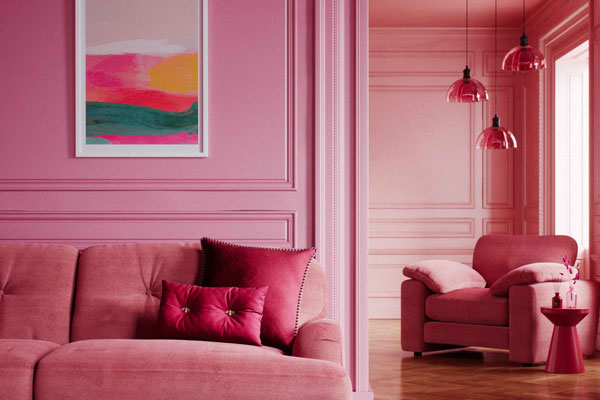Say goodbye to plain white ceilings and hello to bold colours, patterns and materials.
We’re entering the era of the decorated ceiling. Usually painted with white emulsion and forgotten, this hugely under-appreciated area of our homes has recently started to become more of a focal point – an area employed to introduce style, colour and character.
Past Glories
Decorative ceilings have a long and impressive history, all the way back to the elaborate designs of the Ancient Greeks and coffered ceilings (made of a grid of recessed panels) of the Romans. The Baroque and Rococo periods saw extravagant, gilded stucco – in the Palace of Versailles, for example – intricate wood carving and marvellous frescoes. These were, of course, reserved for grand palaces and aristocratic abodes. In Victorian times, UK homes often had tinted ceilings with plaster mouldings. Then in the 1960s came Artex, a plaster-like coating which allowed non-plasterers to create stippled and swirled designs. It went out of favour in the 1980s when the risks of asbestos contained in older Artex became widely recognised.
Today, once again, interior designers are seeing an opportunity to integrate this underused ‘fifth wall’ into the overall room scheme.
So, what is possible today?
Make A Statement With Paint
You can – of course – paint your ceiling any colour you like. The dramatic ‘colour drenching’ fashion means painting walls and the ceiling the same shade. In a white or pale room, you could cover the ceiling in a deeper colour to add unexpected interest, coordinating with a tone from elsewhere in the room. Alternatively, if you have a picture rail, you could paint the area above it the same colour as the ceiling.
Using a dark colour has the effect of lowering the ceiling and creating a cosy atmosphere, while light colours make the room seem more airy. If you have beams or decorative plasterwork, such as detailed cornices or a ceiling rose, another option is to pick them out in a contrasting colour to that of the ceiling.
Murals, Trompe L’oeil & Paint Effects
With a steady hand, lots of patience and some artistic flair, it’s possible to paint anything you like on a ceiling, whether that be an abstract design, geometrics, bold stripes or even florals. Hand-painted drifting clouds or a starry sky look beautiful in a bedroom or living space. If you’re feeling bold, you may want to consider using a metallic or high-gloss paint to add glamour and help bounce light around the room. Beware: this will show up any imperfections in the ceiling surface.
Wallpaper Perfection
Wallpapering walls can be tricky enough, but ceilings are even more difficult, so this option will probably involve a professional. That said, the expense and effort should be worth it: a ceiling covered in a statement wallpaper is a glorious thing. In an otherwise plain room, this could be the finishing touch, or it could be a continuation of the walls. It’s not for the faint-hearted but definitely worth considering.
Material Change
How about stepping away from conventional plasterboard and installing a ceiling made from rustic timber, tongue-and-groove or smart wooden slats? Some wood panelling is also acoustic: helpful in an apartment or a busy home. If you’re feeling daring, you could consider other materials, such as Victorian-style tin tiles, cork (another acoustic option), glossy ceramic tiles or even tented fabric for a quirky, circus-like feel. One thing’s for sure – there’s no longer any need for your ceiling to be overlooked.




